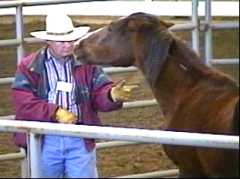Controlling the Beast Within the BeastHorses that Bite! |

|
© 1995, Willis & Sharon Lamm
 Biting can be a dangerous habit. In the nippy horses section we described
a woman who was killed by a biting horse. A horse which bites must be
taken seriously and this habit must be corrected.
Biting can be a dangerous habit. In the nippy horses section we described
a woman who was killed by a biting horse. A horse which bites must be
taken seriously and this habit must be corrected.
Horses will bite for a number of reasons. Young horses will, through biting, test their social standing in the herd. A horse may bite out of pain or fear. Sometimes a horse may bite as a last resort expression. For example, a cinchy horse whose saddle hurts him may start acting aggressively when his rider overlooks his more subtle complaints. Discomfort Biting:Dominance Biting:These games are usually played out between horses of relatively equal standing. In contrast, the lead horse in the herd seldom accommodates such horseplay and will swiftly send the pretender away when first approached. In such instances where the pretender is also very dominant, a more serious exchange may ensue which often includes rearing, kicking and other injury inflicting actions. Therefore it is paramount that the horse handler establish respectful dominance in younger horses before the problem escalates. Humans, need to shut down, not incite, this "nip and tuck" game. When we perceive a bite coming from a young horse, we immediately fend off the bite with a reasonable and appropriate response (not overreacting), followed up immediately by sending the horse out of our space, such as to longe in a circle. This immediate follow-up is the key to this behavior modification as it emulates the herd leader's response of "I'm boss, I'm not playing this game, so beat it!" What we strive to avoid is a situation where we correct the approaching bite, but allow the horse to come right back into our space. This discipline is more suggestive "nip and tuck". Too many times we've observed a horse reaching for a human, the human popping him back, the horse tipping his head to another angle and reaching again, the human popping him again, in what the horse perceives is a playful cycle. Generally once the human buys into the game, the intensity increases until one or the other gets hurt or gives up. Additionally, the horse now thinks he has a willing game partner and will likely try again. Aggressive Biting:The art to this situation is to make the horse run (a trot is usually sufficient), stop, back and turn as directed, and as soon as the horse accepts direction and is doing his job, the human should let him relax. Through repetition, the horse will figure out that aggressive behavior results in a display of dominant behavior from the human which in turn results in work; but that respectful, responsive behavior brings a reward; rest! Human responses to biting must be swift, but not overly severe. Prompt, reasonable responses will help fix the problem. Overreactions, overt anger and macho displays often escalate the aggression. Sensible approaches to behavior modification are the keys to unlocking long lasting solutions. Also, once you know a horse is a biter, set up the situation to your advantage before handling him. Don't put yourself in a situation where the horse can get to you and you can't fix it. If in doubt, get some professional advice and organize a sensible training plan. Biting can be dangerous, however if the underlying causes behind the biting are corrected and reasonable and fair discipline is applied, most horses will become good, safe working partners. Ride safely and enjoy yourself! Press Back to return to the page which brought you hereReturn to KBR Quick Tips Index PageReturn to KBR Horse Health SectionGo to KBR Safety SectionGo To
|
